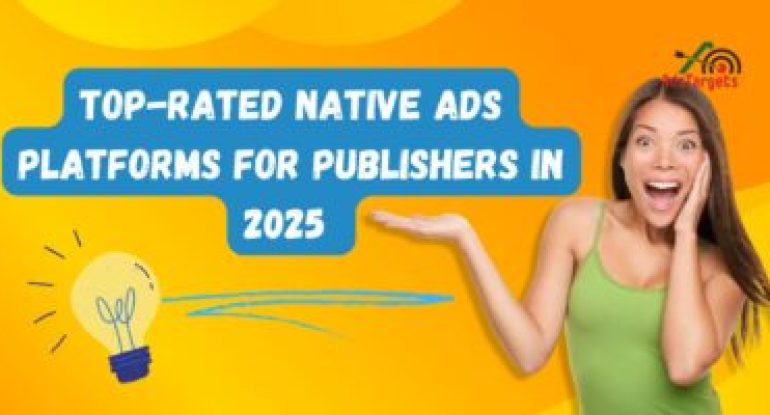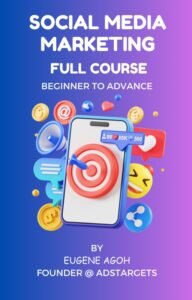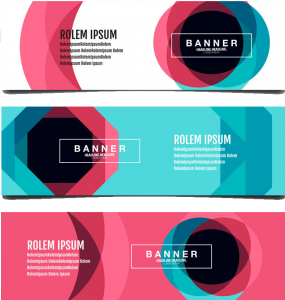With businesses and entrepreneurs tightening their marketing budgets during and after the pandemic, there’s been a big shift in how people spend on ads. And guess what’s rising fast? Native ads—and for good reason.
In fact, by 2021, native ads were expected to bring in 74% of all US display ad revenue. That’s a huge deal. So why are native ads becoming everyone’s favorite?
Well, there are two big reasons.
First, native ads don’t interrupt people the way old-school banner ads do. They’re 53% more likely to catch someone’s attention without being annoying. People actually look at them—and more importantly, they click them. The click-through rate (CTR) is almost 9 times higher than regular display ads. That means more results for the same budget.
Second, these ads blend in with the content people are already reading or watching. They feel natural, not pushy—which makes them way more effective.
That’s exactly why more advertisers and publishers are turning to native ads platforms for publishers. These platforms offer smarter ways to run ads that actually work—and they help publishers earn better revenue from high-quality traffic and real engagement.
Whether you’re running a blog, news site, or niche content platform, choosing the right native ads platforms for publishers can make all the difference in how well your ad strategy performs.
So… which ones should you be looking at? Let’s dive into the best native ad networks out there and see what they offer.
Table of Contents
ToggleWhat Is a Native Ad Network? (And Why Publishers Love It)

Before we dive into why these platforms are so powerful, let’s keep it simple—what exactly is a native ad network?
Think of it like this: native ads platforms for publishers are special tools that connect advertisers (the people who want to promote something) with publishers (the people who run websites or blogs). But they do it in a way that doesn’t feel like advertising at all.
Unlike traditional ads that pop up or flash in your face, native ads blend right into the content you’re already reading or watching. They look and feel like a natural part of the website—almost like they belong there. That’s why they’re called “native.”
Instead of shouting “Hey, this is an ad!” they quietly suggest, “Here’s something you might like.” And people love that. It feels smooth, not spammy.
This smooth experience is exactly what makes native ads platforms for publishers so popular. They allow publishers to show ads that don’t interrupt the user’s flow but still get noticed—and clicked.
And here’s the cool part:
71% of users say they connect better with brands that use native ads (compared to only 50% with regular display ads).
Over 86% of ad impressions—that’s the number of times an ad is seen—come from native ads. That’s huge!
So, if you’re a publisher looking to grow your site’s income without annoying your audience, native ad networks are the way to go. Let’s check out why they matter so much—and how to choose the right one.
The Best Native Ads Platforms for Publishers (That Actually Work)

So now that you know what native ads are and why they matter, let’s talk about the best native ads platforms for publishers. These platforms make it easy for you—whether you run a blog, news site, or niche content hub—to show ads that don’t feel like ads but still bring in clicks and cash.
Here are some of the top platforms out there:
#1. Outbrain
Outbrain is one of the most popular native ads platforms for publishers. It places content-style ads on big-name websites like CNN and MSN. If you want serious reach and high-quality traffic, this one’s a winner.
#2. Taboola
You’ve probably seen Taboola ads below news articles—they say things like “You might also like…” That’s Taboola doing its thing. It’s great for both small and large publishers and has a huge ad network.
#3. Paved
Paved focuses more on native advertising through email newsletters. If you have a strong email list, this is a unique platform that helps you monetize it with sponsored content.
#4. Yahoo Gemini (now Yahoo Native)
Yahoo’s own native ad platform delivers ads across its news, email, and search platforms. It’s a solid option if you want your content to be seen on trusted, high-traffic Yahoo properties.
#5. Nativo
Nativo lets you fully customize your native ads so they match your site’s design perfectly. It’s all about blending ads naturally into your content to boost engagement without ruining user experience.
#6. TripleLift
TripleLift is known for its image-rich native ads. It’s a good pick if you’re big on visual storytelling and want ads that look clean, sharp, and modern.
#7. RevContent
RevContent is one of the fastest ad platforms out there. It focuses on helping publishers grow revenue with lightning-fast load times and strong audience targeting.
#8. MGID
MGID serves up global reach and offers detailed targeting options for publishers who want to reach specific audiences. It’s great for content-driven sites with steady traffic.
All of these native ads platforms for publishers are built to help you earn more while keeping your audience happy. The right one for you depends on your content, your goals, and where your audience hangs out online.
Popular Types of Native Ads (And How They Blend In So Well)
Native ads are great because they don’t feel like ads. They match the look and feel of the website or platform they appear on, so they don’t interrupt the user experience. But here’s the fun part—there isn’t just one way to do native ads. In fact, the top native ads platforms for publishers give you several creative formats to choose from.
Let’s break down the most common types and where you’ve probably seen them in action:
#1. Content Recommendations (a.k.a. “You Might Also Like…”)
These native ads show up as suggestions for more content—usually at the bottom of a blog post or news article, and sometimes even in the middle.
They look like links to related stories, but they’re actually sponsored content designed to grab your interest and get you to click.
You’ll find these everywhere—from major news sites like CNN and Forbes to personal blogs. They’re great because they feel like part of the natural reading flow.
Most native ads platforms for publishers (like Taboola and Outbrain) specialize in this type. It’s perfect for driving traffic without disrupting your audience’s reading experience.
#2. In-Feed Ads (Look Just Like Regular Posts)
Ever scroll through your Instagram or Facebook feed and see a post that looks like just another update… until you spot the tiny “Sponsored” tag? That’s an in-feed native ad.
These ads blend in so smoothly with your regular content that people don’t get that “I’m being sold something” feeling. That’s why they work. They can include videos, images, carousels, or plain text posts—whatever fits the vibe of the platform.
Publishers love this format because it feels native to the social feed, and native ads platforms for publishers make it super easy to customize the look, feel, and message to match the platform exactly.
#3. Search and Promoted Listings (Ads That Look Like Search Results)
If you’ve searched for something on Google, Bing, or even Amazon, you’ve seen these in action. The first few results at the top often say “Ad” or “Sponsored,” but they look just like regular search results.
These native ads show up exactly where people are already looking for answers, products, or services. They match the format of the search engine, which makes them less jarring—and more likely to be clicked.
For eCommerce platforms, real estate sites, travel booking portals, and marketplaces, this type of native ad can be a total game-changer.
#4. Sponsored Content (Full Articles That Tell a Story)
This is a more in-depth form of native advertising. It’s not just a small ad—it’s an entire article or video created to promote a brand or product. But it’s written or produced in a way that still feels educational, interesting, or entertaining.
You’ll usually see sponsored content on news sites or content-heavy platforms. The trick is that it feels helpful, not salesy. So the reader gets value, and the advertiser builds trust.
This format works well for publishers who want to go beyond clicks and deliver deeper engagement.
#5. Custom Widgets or Branded Experiences
Some native ad platforms even offer interactive ads—like polls, quizzes, slideshows, or mini-games that live inside a publisher’s content. These are fully tailored to the site and often offer a more immersive brand experience.
They’re fun, memorable, and can boost both brand awareness and time spent on your page.
So Which Format Should You Use?
That depends on your content, audience, and goals. If your readers love browsing articles, content recommendations might be your best bet. If your site gets traffic from social or search, in-feed and promoted listings might be the way to go.
Thankfully, the best native ads platforms for publishers—like Taboola, Outbrain, MGID, and Nativo—offer multiple formats so you can test and see what works best.
Why Native Ads Work So Well (With Real Benefits Publishers Can’t Ignore)

Native ads aren’t just stylish—they actually perform better than the old-school banner ads that scream “Buy me!” In fact, both advertisers and publishers are seeing the rewards of using native ads that blend in naturally with site content.
If you’re using one of the top native ads platforms for publishers, here are five big benefits you can expect—and why it might be time to make the switch.
#1. Higher Engagement and More Impressions
Let’s face it—most people scroll right past traditional ads, or worse, block them entirely. But native ads are different. Because they look and feel like real content, users are 25% more likely to actually look at them—and 53% more likely to interact.
That means more clicks, more attention, and ultimately more conversions. Native ads don’t interrupt the experience, so users stay happy while advertisers get results. It’s a win-win.
With the help of native ads platforms for publishers, your site can deliver ads that get seen, clicked, and remembered—without annoying your readers.
#2. They Feel More Relevant to Readers
One big reason native ads work? They match the vibe of the page they’re on. Instead of popping up like a random banner, they show up right where people are already reading, scrolling, or watching.
Because they’re placed within relevant content, they feel more useful—not like they’re invading your space. And when users trust the content, they’re more likely to click, share, or even buy.
This kind of contextual match builds long-term brand loyalty and improves the chances of turning one-time visitors into returning customers.
#3. More Control for Publishers
Unlike traditional display ads, where you never really know where your ad might end up, native ads give you more say in the matter. You can decide where they show up, what they look like, and who sees them.
Using native ads platforms for publishers, you can target ads based on things like:
Topic or category
User intent or behavior
Content relevance
This means better ad placement, better experience for your audience, and better results for advertisers.
#4. Better Reach (Without Ruining the User Experience)
Let’s be honest: most people hate pop-ups, flashy banners, or anything that breaks the browsing flow. That’s why so many use ad blockers. But native ads? They fly under the radar—in a good way.
They blend in so well that even if someone’s not interested, they can simply scroll past. No harm done. And because native ads are less likely to be blocked, more of your content actually gets seen. More reach = more potential clicks.
That’s one reason why native advertising is becoming the go-to choice for modern brands and publishers alike.
#5. Perfect Fit for Mobile and Tablet Users
Banner ads often look awkward (or don’t show up at all) on mobile screens. Native ads, on the other hand, are super flexible.
They’re responsive, which means they automatically adjust to fit any screen—whether it’s a smartphone, tablet, or laptop. They appear like just another in-feed post or article, so they feel like a natural part of the browsing experience.
Thanks to smart design options from native ads platforms for publishers, your ads will look great on any device, helping you reach more users without sacrificing quality or user experience.
If you’re a publisher trying to boost engagement, improve revenue, and still give your audience a smooth, enjoyable experience, native advertising is your best friend. And with the right native ads platforms for publishers, you can unlock all these benefits with less stress and better results.
7 of the Best Native Ads Platforms for Publishers (That Actually Deliver Results)

By now, you know that native ads platforms for publishers are a smart way to show ads that blend in with your site’s content without annoying your readers. But with so many networks out there, which one should you go with?
Here’s a quick breakdown of some of the best and most reliable platforms that publishers (big and small) are using to boost revenue and get better results with native advertising.
#1. Outbrain – For Big Publishers With Big Reach
Outbrain is one of the most recognized native ads platforms for publishers out there. Huge names like BBC and The Guardian use it. It lets you show in-feed and in-article native ads—both display and video—and connects you with premium advertisers through programmatic demand.
✅ Minimum traffic: Over 10 million page views
✅ Payment model: CPC or CPM
✅ Minimum payout: $0
If your site has big traffic, Outbrain is a powerful way to scale your monetization.
#2. Taboola – Trusted by Top Media Brands
Used by USA Today, The Huffington Post, and many others, Taboola is another top-tier choice. It’s great for driving traffic and keeping users engaged with recommended content.
✅ Minimum traffic: 1 million monthly views
✅ Payment model: CPC
✅ Minimum payout: $100
✅ Features: Geo-targeting and strong analytics
Taboola is easy to use, especially for publishers who want reliable income from large audiences.
#3. Paved – Native Ads in Email Newsletters
Paved takes native ads beyond websites—it puts them directly into newsletters. Advertisers like HubSpot and Dropbox love it because it targets specific audiences with sponsored content delivered straight to inboxes.
✅ No traffic minimum
✅ Focus: Email-based native ads
✅ Self-service platform with A/B testing
✅ Bonus: Target by job title, industry, and more
Paved is perfect if your strength is email marketing and newsletters.
#4. Yahoo Gemini (Now Yahoo Native)
Yahoo’s native ad platform lets you place ads across Yahoo, AOL, TechCrunch, and other major properties. You can import campaigns from Google Ads and choose from a variety of formats, including video and carousel ads.
✅ Minimum traffic: 10,000 monthly page views
✅ Multiple ad formats: Mail ads, Moments, app installs
✅ Great for: Medium-sized publishers
Yahoo Gemini is user-friendly and gives you access to a huge content network.
5. Nativo – Clean and Customizable
If you’re a content-heavy publisher who loves control, Nativo is worth checking out. It’s known for seamless ad integration and flexible options. No traffic limit means it’s open to newer publishers too.
✅ No traffic restrictions
✅ Minimum payout: $50
✅ Payment model: eCPM and vCPM
✅ Features: AdStore for selecting monetization partners
This is a favorite among news publishers who want native ads to look and feel like their actual site content.
#6. TripleLift – For Visual Storytellers
TripleLift is a programmatic native ad platform that focuses on beautiful, image-rich formats. It supports in-article, in-feed, carousel, and video ads—and gives you access to real support when you need help.
✅ No minimum traffic requirement
✅ Minimum payout: $50
✅ Payment models: CPM and CPC
✅ Bonus: Dedicated account manager available
TripleLift is a good pick if your website relies heavily on visuals and storytelling.
#7. RevContent – Fast, Flexible, and Feature-Packed
RevContent claims to deliver over 250 billion content recommendations per month. It’s fast, flexible, and great for publishers who want to scale and test quickly.
✅ Traffic requirement: 3 million monthly views
✅ Payment models: CPC and vCPM
✅ Minimum payout: $50
✅ Self-service platform with full control
It’s a go-to choice for experienced publishers looking for massive reach and fine-tuned control.
Bonus Pick: MGID – Easy to Start, Easy to Scale
MGID is perfect if you’re looking for a self-service platform with flexible ad formats and real-time analytics. You can choose from CPM, CPC, or even revenue-sharing models.
✅ Minimum traffic: 90,000 monthly visitors
✅ Minimum payout: $100
✅ Multiple pricing models and ad types
✅ Great for: Growing publishers ready to scale
Which One Should You Choose?
The best native ads platforms for publishers all offer different strengths. Your ideal match depends on your traffic size, content type, and where your audience hangs out.
How to Choose the Right Native Ads Platform for Your Website
Choosing the best native ads platforms for publishers isn’t just about picking the one with the biggest name. It’s about finding the one that fits you—your website, your goals, and your budget. And to do that, you’ve got to look at a few important things before signing up.
Here’s what to consider so you don’t waste your time (or your money):
#1. Is the Setup Easy or Just a Headache?
Some platforms are plug-and-play. You sign up, add a bit of code to your site, and boom—you’re showing ads. But others? Not so simple.
For example, a few ad networks like Media.net require you to manually set up each website. And every one of those sites might need to be approved separately. That can take days—or even weeks. If you’re running multiple sites, this could slow you down big time.
When exploring native ads platforms for publishers, always ask:
“Can I get started quickly, or will I be stuck in setup mode forever?”
#2. Understand the Pricing Models
Ads cost money—and the way they charge you matters.
Most platforms use either:
CPC (Cost Per Click) – You pay only when someone clicks
CPM (Cost Per 1,000 Impressions) – You pay for every 1,000 views
Some platforms only offer one type. For instance, Outbrain doesn’t support CPC ads—so if you’re trying to stay tight on a per-click budget, that might not be your best fit.
Make sure the pricing model works with your ad strategy. If you’re a smaller publisher or testing ads for the first time, CPC might give you more control.
#3. Watch Out for Low-Quality or Spammy Ads
Not all ads are created equal. Just because an ad network fills your site with content doesn’t mean it’s good content.
Some shady advertisers use native ads to push fake products or scammy pages. You don’t want your site visitors clicking on junk—and you definitely don’t want your reputation damaged.
That’s why you should check:
What kind of ads the platform usually shows
Whether they screen or block misleading or harmful ads
If you have any control over which ads show up
A trustworthy native ads platform for publishers should always prioritize quality.
#4. Know the Platform’s Requirements Before You Apply
Each network has its own rules. Some want millions of page views per month. Others are open to newer publishers with smaller traffic.
Before applying, ask yourself:
Do I meet the traffic requirement?
Do I have the budget to get started?
Will I have access to the features I actually need?
There’s no point wasting time on a platform that requires 10 million monthly visitors if your site only has 100,000. Match your numbers to their expectations, and you’ll avoid unnecessary frustration.
The best native ads platforms for publishers aren’t always the ones with the most bells and whistles. They’re the ones that fit your website, offer flexible tools, and help you earn without messing up your reader’s experience.
Conclusion
Whether you run a blog, a news site, or any kind of media platform, one thing’s for sure—user experience matters. When your visitors enjoy their time on your site, they stay longer, trust you more, and are more likely to come back.
That’s why more and more publishers are switching to native ads—and using native ads platforms for publishers to make it happen.
Unlike pop-ups or flashy banner ads that interrupt everything, native ads blend in with your content. They look like part of your blog post, video feed, or article stream, so your visitors can keep scrolling, reading, or watching without feeling bombarded.
It’s like the ad is quietly joining the conversation instead of shouting in your face.
So, Why Is This So Important?
People today have short attention spans and zero patience for annoying ads. If something pops up and blocks their screen, they’re likely to close the tab or turn on an ad blocker.
But native ads? They respect the space. They deliver the message without disturbing the experience. And because they’re better aligned with the content your audience is already enjoying, they actually perform better.
Advertisers love this too. That’s why they’re increasingly leaning on native ads platforms for publishers—because they know these platforms offer better engagement, more clicks, and happier audiences.
Bottom line: if you want to monetize your content without scaring your readers away, native advertising is the way to go. And the right platform can help you do it easily, effectively, and without compromising your site’s vibe.








